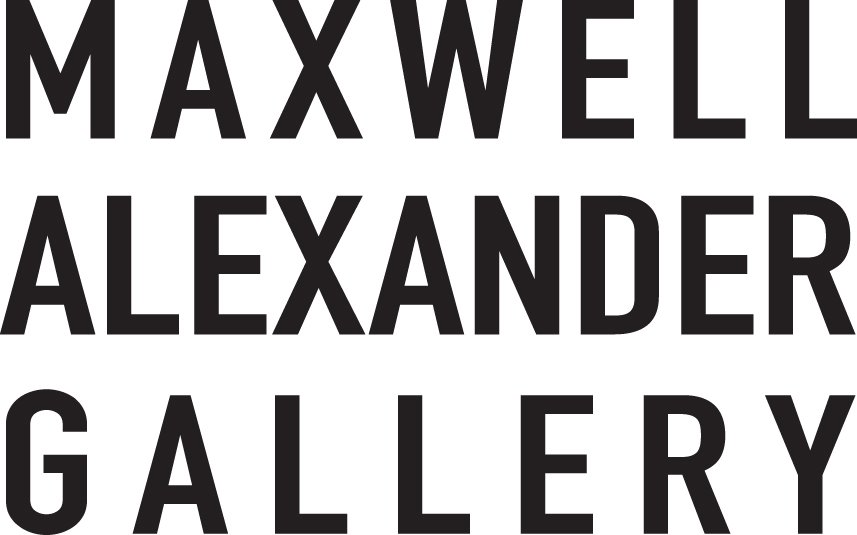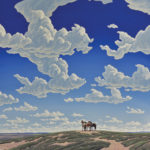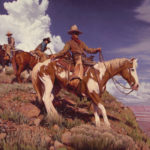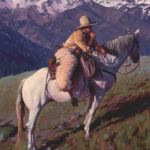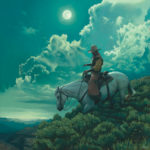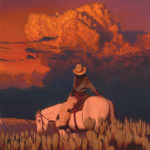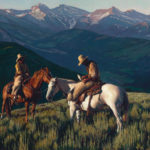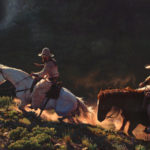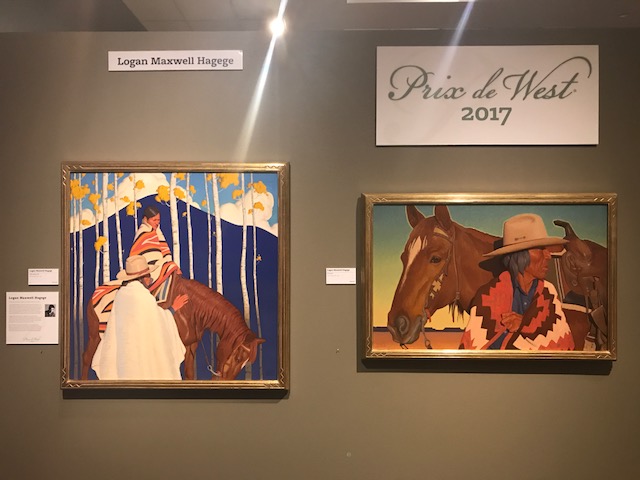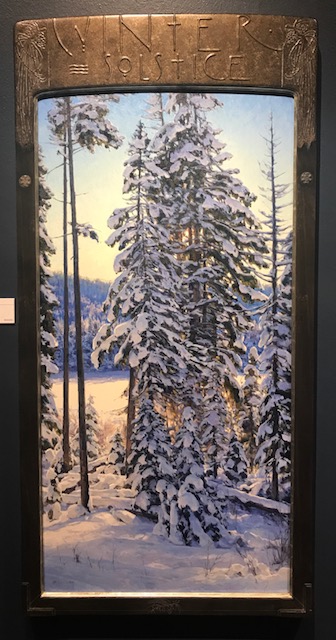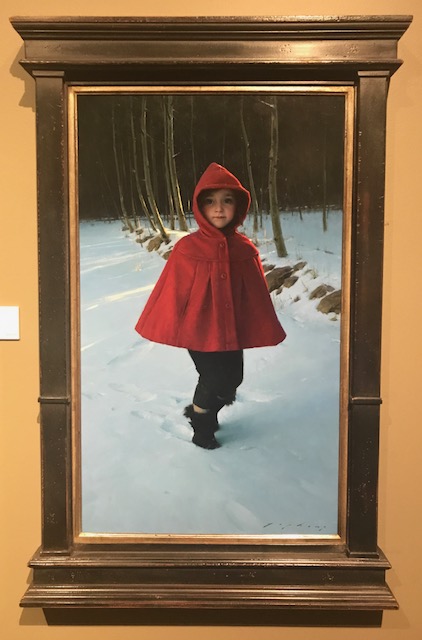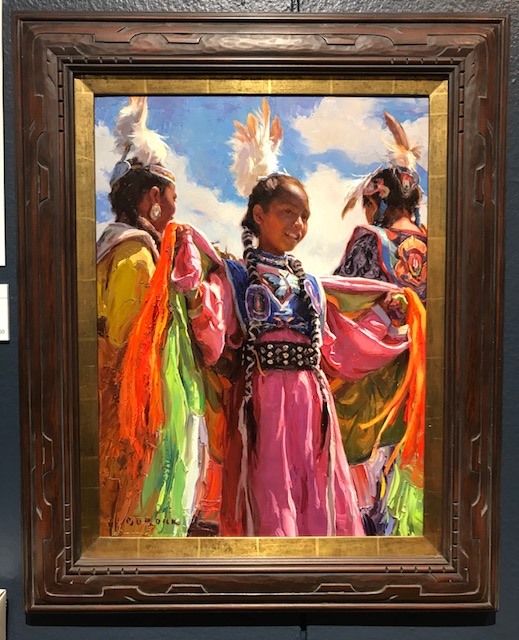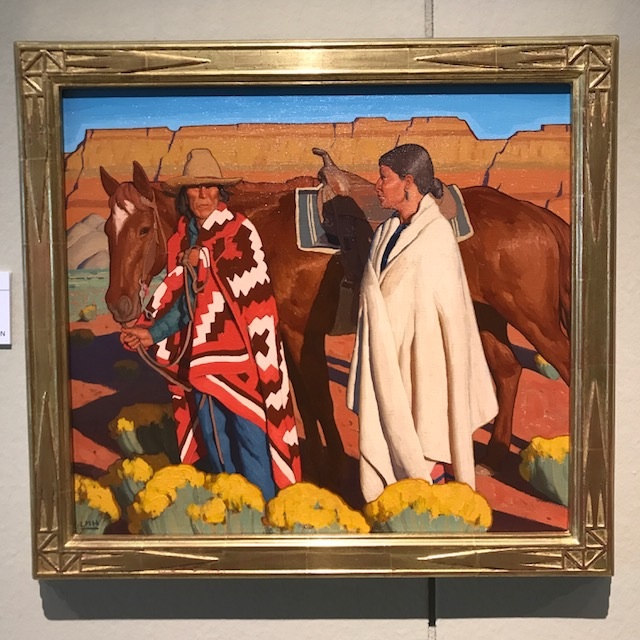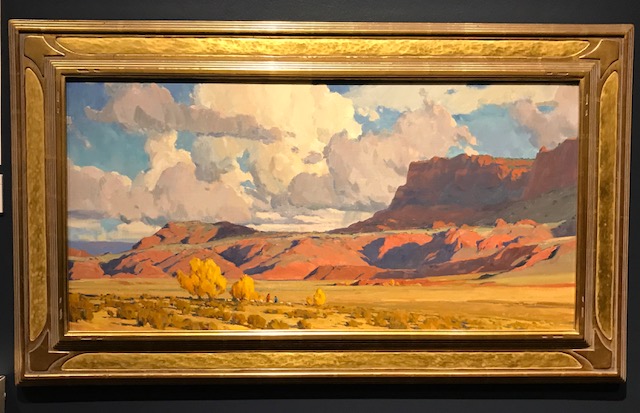Maxwell Alexander Gallery's upcoming shows and recent move to Los Angeles from Culver City are discussed in this new interview with Western Art Collector.
American Art Collecter Interviews Maxwell Alexander Gallery
American Art Collector interviews gallery director and owner Beau Alexander on Maxwell Alexander Gallery's direction as an industry leader.
Southwest Art Previews Cumulus Show
Los Angeles, CA
Maxwell Alexander Gallery, March 10-31
Dennis Ziemienski, Summer Thunderhead, Monument Valley, oil, 20 x 30.
We probably take them for granted more often than we should. This month, however, clouds receive a well-deserved tribute at Maxwell Alexander Gallery, where 12 leading western artists portray these billowing beauties of the sky in more than a dozen new paintings of the American West. Fittingly titled Cumulus, the exhibition opens on Saturday, March 10.
Devotees of historic western art might presume the show is a commemorative nod to early western landscape painters like Maynard Dixon (1875-1946), who frequently depicted massive, showstopping cloudscapes over low-lying horizons. But gallery owner Beau Alexander is quick to note that, while this group of contemporary painters may be influenced by such artists, it’s not the focus of the exhibition. “We’re really trying to look forward,” he says. “These artists are cutting their own path and doing something a little different.”
Among those portraying clouds in a new light are Eric Bowman, Scott Burdick, Phil Epp, Danny Galieote, and Michael Klein. The artists were invited to interpret the theme in any way—and any size—they saw fit, notes Alexander. The result is a diverse collection of cloud-infused scenes that range in tenor from whimsical to contemplative.
Bowman, a western native, has given the theme plenty of thought himself. “Clouds are such enigmatic elements in our landscape’s skies, constantly moving and shape-shifting, especially here in the West where they’ve helped define wide-open spaces like Montana’s Big Sky Country,” he says.
Clouds typically play a “backup role” in his landscape paintings, says the Oregon artist, but in his major work for the show, titled "Levels and Degrees" they take center stage. “I wanted to create some cloud iconography using various levels of depth, large-mass shapes, and temperature shifts to convey a larger-than-life impact,” he explains. Bowman strategically set his cloudscape over southern Utah’s ancient bluffs and canyons, both to support the composition’s vertical design and to create a “large-scale, heroic feel,” he says. “As a design feature, clouds can theoretically be shaped into any configuration imaginable, and in this case, hopefully they inspire our imagination about how large and legendary the West really is.”
Landscape artist Phil Epp has been painting clouds for years, and like Bowman, he thrills in their potentially endless configurations. In his cloud-dominant painting "Hilltop Trio", Epp portrays a triad of horses in the Kansas hills near his home. They are dwarfed, however, by a cobalt-blue sky with plump, unfurling clouds that fill nearly 80 percent of the picture plane. “In my imagery, it’s basically earth and sky, and clouds become the characters of the scene,” says Epp. “I don’t intend for them to be realistic. I make an effort to show vastness, space, and emptiness. Out West, you’ve got the ground ahead of you and the sky above you, and that’s about as basic and primal as it gets.”
If anyone can inspire us to glance skyward with a deeper appreciation for clouds, surely this group of artists can. “We all know what clouds look like,” notes Alexander, “but it’s not until master artists share their vision that our own vision opens up.” —Kim Agricola
To view the Cumulus exhibition, click here.
Logan Maxwell Hagege Featured on the Cover of Western Art Collector
Logan Maxwell Hagege's painting " Pursuit of Happiness" is featured on the cover of February 2018's Western Art Collector Magazine. This painting will also be on display at the Autry Museum this February. Congrats to Hagege on another excellent piece.
To view more work by Logan Maxwell Hagege, click here.
Josh Elliott Featured on the Cover of Southwest Art's Feb 2018 Issue
Josh Elliot's painting is featured on the cover of Southwest Art Magazine's February 2018 Issue.
To view more work by Josh Elliott, click here.
Maxwell Alexander Gallery Celebrates their Five Year Anniversary
Dear Art Enthusiasts, Artists, Friends, and Family:
My name is Beau Alexander, owner and operator of Maxwell Alexander Gallery. I am happy to announce that today, December 15, 2017, is officially the five year anniversary of our gallery.
On December 15, 2012 we held our first exhibition opening simply titled: "Grand Opening." The show, which opened in our Culver City location, featured some of the best realist artists in the country including Kim Cogan, Glenn Dean, Logan Maxwell Hagege, Jeremy Lipking. David Kassan, Billy Schenck, and Joseph Todorovitch, just to name a few.
I clearly remember the night before I had a dream (or nightmare)-- that literally no one showed up to the opening. Why would they? We opened the gallery with almost no press, no investment, no advice. It took us a month to open our doors because we couldn't get an insurance company to grant us a fine art policy. We had to personally guarantee the building lease incase of a default. The only weapon in our arsenal was our vision. Our vision came from the mind of my brother and artist, Logan Maxwell Hagege. It was to create a safe space, where artists were treated right, and most importantly to give a group of young quality artists a venue to shine: The New Breed of Fine Art. That was and still is our tagline. To my surprise, we had over 400 people attend opening night...a line down the block -- it was clear that collectors understood our vision, we didn't have to explain it. (continued below)
Maxwell Alexander Gallery: Grand Opening 12/15/12
It didn't hurt that my brother's artist friends were some of the best in the country. The only reason our gallery has been successful is because of the artists that have agreed to associate themselves with us. Without their trust in us we wouldn't have lasted a year, let alone five. Social media has also played a large role in our success. It only seemed natural to us - share good art, people will respond. And you have.
Our knowledge and experiences in the art world have made our gallery a magnet for not only the best artists, but emerging artists as well. Noted discoveries that had never shown in a gallery prior to Maxwell Alexander Gallery include Brett Allen Johnson, Mark Maggiori, and Vincent Xeus. All three are names you probably know by now. Early on we became known for our themed group exhibits that brought together different genres and artists that would have never thought they'd be showing together in the same space. Our Black Friday exhibit was created so young collectors would have a chance to live with and feel the power of original art in their homes (Black Friday 2017 sold 50 pieces of original art in one day).
We were the first gallery to show Glenn Dean's figure series - they've been selling out ever since. We hold the price record sale for Logan Maxwell Hagege for his 2016 painting "Doorway in the Sky," 80"x80" Oil. We've hosted numerous sold out exhibitions, including four in 2017. We've revitalized and propelled numerous others simply by presenting their work in a different light. We regularly consult for museums around the country who are trying to figure out why artists and collectors want to be part of the movement we've created. It's no surprise museum show rosters look very similar to our own. (Cont. below)
Glenn Dean "Holding Steady" Oil 30"x30"
Logan Maxwell Hagege "Doorway in the Sky" Oil 80"x80"
Mark Maggiori "Down the Wash" Oil 40"x40"
Vincent Xeus "Emma Choosing" Oil 30"x20"
We've been bullied by older galleries and misunderstood by certain collectors - but there is no doubt that those who are able to look forward understand.
As I reminisce on the last five years I can't help but look forward. We recently moved into a 3500 sq ft gallery with 16 foot high ceilings in booming Downtown Los Angeles. We are hosting major exhibitions in 2018 that include artists: Cesar Santos, Sean Cheetham, Mian Situ, Danny Galieote, G. Russell Case, Eric Bowman, and a joint show with Joshua LaRock and Michael Klein. New works in the gallery from John Moyers, Serge Marshennikov, Ed Mell, and Tim Solliday are just a few other things to look forward to. We have started to include installations and interactive exhibits during our openings. In my opinion the traditional art opening has become stale. We are constantly experimenting to keep fine art interesting - especially to the new generation of collectors. I'd like to invite everyone to visit our new arrivals page where we try to highlight new works that we receive on a weekly and monthly basis. You can do so by clicking HERE
I can go on forever, but I'd like to end by thanking all of our supporters, collectors, magazines who write articles on our openings and the artists we represent. I'd like to thank Logan Maxwell Hagege for creating a movement that has given many artists a new life. Most importantly I'd like to thank all the artists that have shown or wanted to show in our gallery. We all owe a debt to you.
Peace and Love,
Beau Alexander
Jeremy Mann Installation during OPUS 27 solo exhibition July 2017
Serge Marshennikov "Resting" Oil 23"x32"
John Moyers "Tres Hermanos" Oil 36"x24"
Brett Allen Johnson "Refuge Under an Arid Sun" Oil 40"x36"
Maxwell Alexander Gallery's New Location
Southwest Art Previews Mark Maggiori Show
Show Preview | Mark Maggiori
By: Southwest Art | November 15, 2017
Mark Maggiori, In Altitude, oil, 24 x 30.
by Laura Rintala
A cowboy peers down at the rocky trail as his horse picks its way through the loose rock and sagebrush, while behind them the ground falls away to distant snowcapped peaks against a blue sky. In another scene—a nocturne—another cowboy shifts his weight in the saddle and gives his horse rein to make its way down a steep, shrubby incline, the full moon highlighting distant canyon walls. These two paintings, and seven more canvases that examine the often solitary beauty of cowboy life, are on view this month in Mark Maggiori’s solo show entitled Lonesome Souls. It opens at Maxwell Alexander Gallery on Saturday, December 9, with an artist’s reception from 6:30 to 8:30 p.m.
“When I started work for the show, I was going up to Wyoming [and photographing] cowboys,” Maggiori explains. “For two or three days we were on the Continental Divide. It was very inspiring for me visually. When I came back, I wanted to paint what I had just experienced.” After working through his photos and making sketches, the artist realized a recurring theme: “I ended up painting mostly lonesome cowboys,” he says. “My feeling is that the cowboy life is very lonesome. It’s a feeling of being far from world reality and having symbiosis with nature.” And the painter, alone in his studio day after day, recognized the parallel to his own work. “There’s the beauty of [that solitude] as well as the hard part,” he says.
Lonesome Souls is Maggiori’s second solo show at the gallery and, notes gallery director Beau Alexander, his second solo show ever. “In this show we’re seeing Mark’s style develop. His ability as an artist and his voice as an artist has really matured since his first show in 2015. This show is cohesive and focused on the lonesome cowboy on the range in different scenarios.”
Maggiori pays particular attention to making his images timeless. “I don’t want to mark [a time period] through [the tack or] gear—when you’re a specialist you know it is [contemporary]. But I want to stay on the iconic side of the West,” he says. “That is what brought me to paint cowboys. That is what I have been fascinated with.”
And those cowboys are depicted as larger than life. “I cheat scale. My cowboys are 20 times bigger than they are supposed to be,” he says. And while there is limited human interaction depicted, Maggiori explores other relationships. “We don’t say enough about how important the horse is to that person being in that place and having that experience,” he says.
“The solo show is such a special event for collectors,” Alexander says. “In group shows you see one or two paintings by an artist, maybe three. But you can’t know an artist without seeing them in a solo exhibition, their small works, large works. Mark’s been working on this show for a long time, and we’re excited to be able to present it to the public.”
For more work by Mark Maggiori, click here.
Western Art Collector Previews Logan Maxwell Hagege Show
Western Art Collector: November 15, 2017
BY MICHAEL CLAWSON
For California painter Logan Maxwell Hagege, the desert, particularly the deserts of the Southwest, are stages on which his players are arranged in Western theater— tableaus of sage and sand, earth and sky, past and present.
“These scenes make sense in my mind—they’re almost like memories—and so I just fill them out as I want them,” Hagege says, adding that his works are often assembled from reference materials gathered for a variety of sources. “I like having that variety...of landscapes, of figures, or artifacts. I start adding these things together—after all, no one is going to see the reference material, only the finished work, so it doesn’t matter—and it starts creating this imagined world.”
Hagege likes to keep his works and their themes ambiguous to his audience, which leaves each individual viewer pondering deeply about his Native American figures, many of whom are posed within the scenery as monuments to the sun, represented with brilliant orange and gold light that pours into the painting from an unseen horizon, and also monuments to time, shown here by his subjects’ untethered place within the larger narrative of the American West. And though the figures are unrestrained by time, they are clearly modern subjects; in Way Out, for instance, a rider with a piercing gaze can be seen wearing blue jeans and a red bandana, both of which are decades away from the man’s first phase Navajo chief’s blanket that he is wrapped in.
These ideas of time and place can be seen in Hagege’s new exhibition opening November 4 at Maxwell Alexander Gallery in Los Angeles. The show will feature six new pieces, as well as a variety of small works.
One of the pieces in the show is Bloom, which shows one of the artist’s favorite models draped in a white blanket as he stands with a horse in front of a simple, almost abstracted background of purple mountains and a large cloud that cuts out a billowy silhouette from the teal sky. Elements of the painting, like the horse and rider, are rendered with exquisite detail, and others, like the background, are flatter and simpler. The effect was intentional.
“I try to have a balance, and Bloom is a great example to illustrate that balance. The mountains are really simplified, but against them is this more complex battle with the figure and the horse and all its tack,” Hagege says. “I end up playing the flat against the more three-dimensional aspects, and I really want to see how far I can push it. Gustav Klimt is one of my favorite painters, and he really was doing some amazing things with that flat, graphical style but then realizing it on a three- dimensional object.”
Bloom also presents an artistic challenge in that there are distinct blocks of color that should not work together, but do, whether it’s from the teal sky and purple mountains, or the yellow and green sage at the rider’s feet—color, even varying degrees of vibrant color, all seem to co-exist pleasingly. “I like to think about it as putting on a pair of tinted glasses, like a rose-colored glasses or even those yellow blue- blockers glasses. The glasses create a color tone that is cast over everything. So when I’m mixing colors, if I’m picturing that color tone over everything it helps my brain process the colors I’m looking at and wanting to achieve in the painting,” he explains. “You sort of have to think in tones or color keys. It’s a very intuitive sort of feeling, which means it’s hard to explain but you know it when you see it because it either works or doesn’t work.”
This shifting color key can be seen in great effect in Go With the Clouds, which shows a male and female figure in a complex arrangement that involves a menacing shadow that looms over the female and her horse, abstracted and elongated shadows on the desert floor, and riders on the horizon that seem to be sinking into the sandy earth. The colors are there, but they are not punchy or vivid. They are informed by the haziness of the fading sunset, which drains the world of its pop of color and replaces it with a copper glow. “I know it doesn’t always seem this way, particularly since some of my works are very colorful, but I’m not really attracted to colorful paintings,” he says. “In many ways I’m more attracted to muted and more subdued works.”
Expanding on that idea, Hagege says that Go With the Clouds was largely conceived as a black-and-white series of shapes on the canvas as a tool to bring out the composition he wanted to achieve. Once he captured the full painting, with its dramatic shapes and figures in the foreground and background, he was able to build up the detail and color he wanted within the world. “N.C. Wyeth and Gustav Klimt, as different as they were, they were creating worlds,” the artist says. “They wanted the viewers to have some sort of experience within these worlds. Even someone like Georgia O’Keeffe, she was looking at the world and making edits, and putting that in her works. She wasn’t showing you the real world, but her world.”
Hagege, like Klimt and O’Keeffe, is building his own world, one where the sun blesses those it touches, the clouds bloom on the horizon and figures ponder their place in time within the desert’s majesty.
For more work by Logan Maxwell Hagege, click here.
Southwest Art Previews Logan Maxwell Hagege Show
By Southwest Art: November 15, 2017
For more work by Logan Maxwell Hagege, click here.
Southwest Art Profiles Tim Solliday
Tim Solliday’s paintings present a poetic vision of an earlier time
By Gussie Fauntleroy
This story was featured in the July 2017 issue of Southwest Art magazine.
The first time Tim Solliday walked into the Los Angeles home and studio of the artist who would become his most important teacher, it felt like stepping into a movie from the 1920s. The ramshackle Spanish-style house was filled with antique furniture and décor: Oriental carpets covered the floors, while paintings, sculptures, stacks of prints, and other art objects were scattered about.
Looking back, Solliday finds it appropriate that Theodore Lukits (1897-1992) seemed to belong to an earlier era. Through the Lukits Academy of Fine Arts, the Romanian-American painter was offering something that—in the mid-1970s, when Solliday studied with him—had long gone out of style in American art education: academic instruction in the atelier manner, taking students slowly through the foundations of drawing and painting, beginning with only black and white.
At a time when representational painting was overshadowed by abstract and conceptual art, Lukits and his school filled a void. “Almost nobody knew who John Singer Sargent was when I was a kid,” Solliday laments. The atelier approach was a perfect fit for someone who left a Long Beach-area college because the art instructors had nothing but ridicule for Norman Rockwell and the other illustrators he admired; someone who since childhood had been mesmerized by great painting but was told it would not be possible to make a living that way. “I thought traditional art was dead on the vine, but I still believed I would do it,” Solliday says. “I always thought there was room for everything in art.”
In fact, he was right. Not only did collectors open their arms again to landscape, still-life, and figurative art, but Solliday—who paid for his art instruction by working as an apprentice billboard painter in Southern California—was right about his own ability to forge a successful career in representational fine art. His widely collected work is now in the permanent collections of the Briscoe Western Art Museum and the National Museum of Wildlife Art and has been exhibited at the National Cowboy & Western Heritage Museum, the Autry Museum, and the Carnegie Museum of Art, as well as other museums and galleries.
Solliday’s early conception of his artistic future leaned toward the illustration field. His father was a technical illustrator for Douglas Aircraft Company, a job that took the family from Solliday’s birth state of Iowa to the Palos Verdes Peninsula in Southern California, where as a young teen he had a horse. Although he had no interest in technical illustration, he was inspired by his father’s artistic ability and obsessed with drawing. Meanwhile, western movies of the 1950s and early ’60s left a lasting impression, offering a glimpse of how effectively visual qualities could stir the emotions and convey particular moods.
When Solliday’s college foray into art turned into disappointment, billboards became his training ground. In those days the work was often done in hangar-sized studios where mechanical scaffolding positioned a painter where he needed to be on the 14-by-48-foot image. Solliday learned to handle paint. He adopted disciplined work habits. He became adept at depicting texture—everything from a beer can to a horse to a girl on the beach. And it was through his fellow billboard painters that he learned of Lukits. In the 1940s and ’50s the billboard company routinely sent painters to Lukits to refine their skills. That was no longer happening by Solliday’s time, but individual billboard painters would go to Lukits on their own after work, often inviting fellow painters in whom they noticed an unusually high level of interest and talent.
So it was that Solliday found himself at Lukits’ home and studio, feeling as if he had stumbled onto a Hollywood movie set. That first night he was the last of the students to leave. Finally glimpsing the possibility of art instruction that matched his goals, he felt a kindred spirit in the older artist, then in his 80s, and the two talked until well after midnight. “I thought, okay, he’s a source of knowledge for me,” Solliday recalls. For five years he went to Lukits’ studio two or three nights a week after work. The intensive instruction began with learning to draw not from live models but from plaster casts or marble sculptures of the human form. From this came an essential understanding of using values of light and dark to produce a sense of three-dimensional form. For Solliday it was a revolutionary way of seeing and of rendering what he saw. “I thought, wow, what a difference from trying to draw from out of your head.”
Eventually, color came into the mix. Lukits would set up still-life arrangements for the students, presenting increasingly complex color problems to work out in paint. He used special lighting to simulate various conditions of outdoor light: intense yellow overhead for midday, blue for moonlight, a slanted angle of warm light for sunset, or a veil to mimic fog. “He was very honest,” Solliday says of his teacher. “He told us we’d never learn true color until we got outdoors, but he also knew it’s very difficult to paint outdoors, so we had a head start.” Soon the young artist could look again at the work of artists he admired and see what made them great. “It was thrilling,” he says.
Among the earlier painters who made a lasting impression on Solliday were illustrator Dean Cornwell (1892-1960) and Cornwell’s mentor, Anglo-Welsh artist Sir Frank Brangwyn (1867-1956). By studying Brangwyn’s paintings and drawings, Solliday began to understand that an arresting composition starts with massive shapes and the juxtaposition of forms. Brangwyn, and Monet before him, also opened Solliday’s eyes to the use of broken color, which lets the viewer’s eye mix colors that are adjacent on the canvas, having been applied as separate brush strokes. “It’s all about colors bouncing off other colors, or the illusion of brightness by adding gray around the strong colors,” Solliday says. “I’m known as a colorist, but if you study my work in person, you’ll see a great deal of gray.”
Solliday especially admires the use of gray to influence color in the work of western painter Frank Tenney Johnson (1874-1939). As it turns out, Solliday worked for a time in the Alhambra, CA, studio that once was Johnson’s. He’s also had use of the former studio of William Merritt Chase (1849-1916). These days the 65-year-old artist stands at his easel in the light-filled space on the top floor of the historic First Baptist Church—one of Pasadena’s largest, built in 1926. With arched stained-glass windows and a high ceiling, the studio has a touch of the medieval but with fresh white walls and state-of-the-art lighting that Solliday installed when he leased the space two years ago. It’s worth all the steps he climbs each day to reach it, he says.
For many years Solliday was known as a landscape painter, capturing California’s natural beauty, especially through his plein-air work. He continues to use the landscape as the setting for his imagery, but now his focus is on the Native Americans, mountain men, and others who carried out their lives on the land. It’s a full-circle swing back to his boyhood fascination with the Old West—minus the confrontation—with special inspiration from the work of the Taos Society of Artists. When Native people and European-Americans interact in Solliday’s paintings, as they do in FRONTIER COMMERCE, it is in quiet encounters reflecting a feeling of mutual respect. The painting, as with much of his work, gave the artist an opportunity to combine intricate details, like beadwork on clothing, within the almost stage-set context of beautifully balanced color and solid, muscular shapes.
Similarly, COURTSHIP places a young Indian couple in a forest of dappled sun and shade as a horse grazes close by. “It’s about love blooming out of the peacefulness,” Solliday says. Both paintings are part of this year’s Prix de West Invitational show at the National Cowboy & Western Heritage Museum in Oklahoma City, on view through August 6. The two paintings reflect the artist’s shift not only in subject matter but also painting style. In both areas, Solliday has moved to a less literal, more imaginative approach. “It’s all based on classical principles of composition, light, and drawing,” he says, “but I had to come to a place that’s a little more free.”
What this means when he starts a new painting is sitting down with paper and scribbling abstract lines and shapes until they begin to suggest compelling forms, and a painting idea emerges from there. Then he turns to his trove of plein-air sketches, his collection of books and artifacts, and a well of artistic knowledge to flesh it out. More important than a literal interpretation is a feeling and mood that “moves the soul,” he believes. Like the best filmmakers who use camera angles, filters, and composition to produce a visually memorable scene, Solliday understands the powerful visceral impact of thoughtfully rendered color and form. “Every time I saw a poetic scene in a movie, especially westerns, it went into my mind,” he says. “And now it’s coming out.”
Southwest Art Previews Joseph Todorovitch Show
Joseph Todorovitch: Explorations in Paint
By Southwest Art: October 15, 2017
The paintings of Joseph Todorovitch are wrought with the beauty of the human figure, striking compositions and a strong understanding of techniques and tools. They are pieces that reach beyond narrative to the artist’s fascination with creating. Todorovitch finds the act of painting to be ceremonial or ritualistic, with this being reflected in some of his artwork such as Rain Maker and Guardian where the women are adorned with crowns of eucalyptus leaves.
“The ceremonial works have a sense of ‘ritual’ that is somewhat absent in my life other than during the process of their creation. They manifest from my feelings about the ‘act of creating things’ that are important to me,” Todorovitch explains. “Creating is spiritual for me (not religious), which is somewhat counter to my everyday life which is rather domestic. I like that these works fulfill that need and express that sentiment about me.”
Other pieces are derived from Todorovitch’s desire to explore design elements. He elaborates that this allows him “to share the domestic pragmatic aspect of my everyday life as well as simply to explore design elements and pictorial issues that are compelling to me. Picture making has become my life and the time spent exploring design has become the spiritual ritual that fills that need.”
Works such as the still life-styled Entropy and the figurative Pollination are examples. The pieces came about when Todorovitch began experimenting with the textural qualities of a group of bees. “Bees are just amazing and there are all these implications that come along with them,” explains the California-based artist.” They were naturally a great design element to use in painting.”
Entropy is a work filled with energy and activity, and came from a moment of chaos in the artist’s life and allowed the painting to take its course. Pollination, he explains, is “such a critical idea of survival and that obviously opens the door for an individual interpretation of the painting.
Other works, such as Greatest Show on Earth, and Ride are explorations with multi-figures, where he is attempting to make the work more complex but yet have a sense of calm and order. The former painting was done from multiple references materials, while Ride is related to another work the artist did of a bicycle he saw in Rome.
“I like exploring different things to see what impacts me the most,” says Todorovitch. “I definitely go back to certain things, but I’m trying to shake up the normal routine with different ideas.”
These and other new works will be displayed in Todorovitch’s second solo exhibition at Maxwell Alexander Gallery in Los Angeles from October 14 to 28.
For more work by Joseph Todorovitch, click here.
Southwest Art Magazine Previews: Taos Group Show
Show Preview | Taos Group Show
By: Southwest Art | August 15, 2017
Los Angeles, CA
Maxwell Alexander Gallery, September 23-October 7
This story was featured in the September 2017 issue of Southwest Art magazine. Get the Southwest Art September 2017 print issue or digital download now–then subscribe to Southwest Art and never miss another story.
Maxwell Alexander Gallery’s annual destination-themed group shows have presented fresh, artistic takes on the majestic Grand Canyon, Vermilion Cliffs, and Monument Valley. This month the show returns with a spotlight on the more intimate but equally cherished setting of Taos, NM, through the eyes of 10 western painters, including G. Russell Case, David Grossmann, Logan Maxwell Hagege, and Tim Solliday. “We’ve invited some of the most well-known contemporary artists who paint this location,” says gallery director Beau Alexander, “but we’ve also included a few artists who traveled to the area for the first time.”
The show opens with an artists’ reception on Saturday, September 23, at 6:30 p.m., when the gallery unveils one or two new paintings by each participating artist. Visitors can expect to see wide-ranging interpretations of the northern New Mexico town and neighboring Sangre de Cristo Mountains. “It’s fun to get a new perspective on such an iconic location,” says Alexander. “Taos will forever hold an importance in the western art market. The Taos Society of Artists were among the most important figures in the western art movement, and many of the artists we represent are influenced by their works.”
That’s particularly true for Utah artist Brett Allen Johnson, who has long been inspired by the Taos Society artists. The landscape painter visited the town for the first time in May with plans to portray the landscape or perhaps the historic church at Ranchos de Taos. “Taos is very beautiful,” says Johnson, “but I left with the impression that the most special thing about it wasn’t the hills and the sage. Native life here was, and is, so thoroughly woven into the land itself, both in utility and spiritually. I knew that the land alone was a very incomplete picture.”
Thus inspired, the artist set out to complete his first finished figurative painting, EARTH AND CLAY, in which he portrays two Indians standing before an adobe structure and mud oven in the centuries-old community of Taos Pueblo. “I hope viewers might feel the connection to the earth, to the soil,” says Johnson of the scene, “but I also hope they will see two individuals with lives and emotions that are more complicated than the stereotypes.”
New Mexico native John Moyers brings two paintings that portray Native Americans against distinctive Taos backdrops. In MEN OF IMPORTANCE, the silhouette of Taos Mountain rises up behind a group of sharply dressed Taos Indians on horseback. “Everything in the painting is authentic, down to their hairstyles, the white blankets, and the leggings they wore in the late 1800s,” says Moyers. “I try to pay really close attention to that.”
The Santa Fe artist has frequented Taos since he was a boy, and he regularly revisits the town’s people and history in his work. “When I was a kid, you still saw the men in the white blankets and the horses around the plaza,” says Moyers. “I consider myself lucky to have seen it. You can’t stop progress, but it’s still a neat place.” —Kim Agricola
contact information
310.839.9242
www.maxwellalexandergallery.com
WESTERN ART COLLECTOR COVERS "TAOS" GROUP EXHIBIT
The small town of Taos, New Mexico, has provided inspiration for Western artists since Joseph Henry Sharp first visited there in 1893. The art haven is the subject of a new group show at Maxwell Alexander Gallery, which opens with a reception from 6:30 to 7:30 p.m. on September 23 and remains on view through October 7, and features the artwork of Danny Galieote, Kim Wiggins, David Grossmann, John Moyers, Tim Solliday and Logan Maxwell Hagege.
“The mix of cultures in Taos, its history and its beautiful surroundings make it a fascinating place to paint,” Grossmann says. His painting Clouded Sunset, Taos, captures an adobe structure called La Morada on the outskirts of Taos, which was part of a Catholic monastery dating back to the late 1700s. “The evening that I did this painting, the silence of La Morada seemed to carry a hidden history, a feeling echoed by the clouds that veiled the glowing sunset. I wanted to capture the sense of deep solitude and the way that the adobe walls seemed so connected to the land.”
In Galieote’s The Watchers, three protectors watch over their Pueblo family. “I wanted the figures to conjure a feeling of order and stability and that nothing could get past their glistening inscrutable eyes,” Galieote explains. “The middle figure seemed to naturally take his place as the wisest and the one who will have the final word to carry forth in war or in peace.”
Taos is an alluring subject for Wiggins. The landscape and the history imbue a sense of importance in his work. “My work, One Night at Taos Pueblo, centers on the iconic San Geronimo de Taos Mission located at the Taos Pueblo,” he explains. “In the painting two beautiful Pueblo children stand outside the mission under the light of a full moon. This painting is both symbolic and ethereal in nature hopefully capturing the very heart and resilience of the Taos people.”
View the show preview HERE
American Art Collector Previews Jeremy Mann's solo exhibition "OPUS 27"
Theater of Light
In the early 20th century Florenz Ziegfeld, creator of the Ziegfeld Follies musical revues on Broadway, was widely known for his muses, elaborately costumed chorus girls often called Ziegfeld Girls. The girls were the primary residents in Ziegfeld’s fantastical worlds of music and drama. “[H]e simply couldn’t stop being more and more lavish with every show,” wrote his wife after his death in 1932. “...the world remembers Mr. Ziegfeld as the man who revealed a whole new world of color and light and gaiety in the modern musical revue.”
Using the iconic Ziegfeld Girls and the era that they thrived in as inspiration, painter Jeremy Mann will be presenting a new collection of work at an exhibition July 15 at Maxwell Alexander Gallery in Los Angeles. The show will open the gallery’s brand-new space, which will be decorated with the installations the artist used for his photo shoots. For the opening guests are encouraged to come dressed in their finest and interact with the installations. The exhibition is a collaboration with Christina Molcillo of Black Lotus Clothing, who used Ziegfeld Girls as models for her designs, including dresses, gowns, headpieces and other antique materials.
“Many good things come out of collaborations in unexpected ways,” Mann says of working with Molcillo. “Wanting to not only keep my hands from detaining the unexpected, but also with respect to another artist’s unhindered personal visions, Christina developed and created the wardrobe and sets with unobstructed direction, based on a few meetings and her own research into my stylistic tendencies combined with her own artistic style.”
Their collaboration can be seen in works such as Luna and Moonlight, both featuring a female figure elegantly dressed in front of a prop crescent moon. Like Ziegfeld’s girls, and the photos of them that have survived, these figures have an element of theater to their presence amid carefully placed light, oversized stage elements and beautifully designed costuming. They are at once sumptuous and also vulnerable within Mann’s cool shadows and delicate brushstrokes.
“Having a theme to hold everything loosely together and give direction, we both have affections for the 1920s and the Ziegfeld Girl style, crossed with some [Alphonse] Mucha and modernity, as well as theater and darkness,” says Mann. “The moon stage grew from that era’s fascination with it as often seen as a moon with a painted face upon the stage. The timeless feeling is always something I prefer in my paintings, creating a haze of memory and capturing fleeting moments in perpetual paintings which draw up those same emotions, something dreamlike and lost, or a thing once wonderful and now forgotten.”
These “dreamlike” qualities overlap with much of Mann’s current state as an artist, in which he says he’s diving further into the cerebral ether of creation. “I suppose these would be my foggy years. I’ve been exploring deeper into the feelings evoked from atmosphere and light, how their effects work both with and against form, while eliciting emotions of fading memories, things past and times ceaseless endurance,” he says. “Logically this exploration evolved from my endeavors with film and Polaroid photography from the homemade cameras, and now into video and films using homemade lenses to capture that same effect, without the need for digital manipulations—I’ve a badinkling about most things digital. Film and video have a direct connection with ‘time’ and that is something which I desire to have a stronger place in my paintings. What an artist does with their time when not painting affects the painting even more than when they are.”
Mann’s show, which will also feature his bold cityscapes, will continue through August 12 in Los Angeles
To view more of Mann's work, click here.
Courtesy of American Art Collector magazine
Maxwell Alexander Artist Len Chmiel Wins Award at Prix de West
Oklahoma City, Oklahoma June 2017
The 2017 Prix de West Invitational Art Exhibition and Sale finished up this year’s successful award’s ceremony at the National Cowboy & Western Heritage Museum this past weekend. The show saw $3.1 million in art sales, and brought out 700 fans and collectors to the event, held in Oklahoma City. Maxwell Alexander Gallery attended to support gallery artists Scott Burdick, G. Russell Case, Len Chmiel, Glenn Dean, Josh Elliot, Logan Maxwell Hagege, Jeremy Lipking, Susan Lyon, John Moyers, Howard Post, Matt Smith, and Tim Solliday.
T. Allen Johnson won the Prix de West Purchase Award and will have his piece “Nursery Tree” joined into the museum’s permanent collection.
Maxwell Alexander Gallery artist Len Chmiel was awarded the first-time Wilson Hurley Memorial Award for landscape painting with piece “Transparent Water Colors”. Bob and Margaret Mills sponsored the award.
The show will continue to exhibit until August 6th, 2017. Included are some highlights from the show below. For more work by Chmiel or other Maxwell Alexander Gallery artists click here.
Love and Resilience, Portrait of Louise and Lazar Farkas, Survivors of the Shoah.
46x42”, oil on panel
Mawell Alexander Gallery Artist David Kassan Wins 2017 Draper Grand Prize
Congratulations to the 2017 Draper Grand Prize & the People’s Choice Award Winner, David Kassan for his painting Love and Resilience, Portrait of Louise and Lazar Farkas, Survivors of the Shoah. The Portrait Society of America awarded Kassan at the 19th annual International Portrait Competition.
“Thank you so much for the Portrait Society of America…This was definitely a dream for me, and I share these awards with the Survivors, whom have all shared their sometimes painful, but mostly glorious and inspiring lives with me.”-David Kassan
More of David Kassan's inspiring work can be viewed here.
Southwest Art Magazine Previews Glenn Dean's "Into the Night"
By: Southwest Art, April 14, 2017
Los Angeles, CA
Maxwell Alexander Gallery, May 20-June 17
This story was featured in the May 2017 issue of Southwest Art magazine.
This month Maxwell Alexander Gallery presents Into the Night, a solo show for Glenn Dean featuring 10 new paintings that explore the light at the end of the day and into the moonlit hours. The show opens with an artist’s reception on Saturday, May 20, from 6 to 8 p.m. “People get used to the light effects in bright works,” says gallery director Beau Alexander, but the more subtle effects found in these works “make the paintings so much more interesting, not only for the artist but for the viewer as well.” While western artists Frederic Remington and Frank Tenney Johnson were well-known for their nocturnes, Alexander says not many artists have really focused on them since then, and Dean felt inspired to do so.
Although Dean has worked with nighttime and sunset scenes in the past, this show focuses on the times of day when light is most challenging to interpret. “I spent most of last summer going out during the last half hour of daylight and doing little color sketches very quickly, working until I couldn’t see anymore,” Dean says. He also spent a lot of time walking around in the moonlight and just observing.
Dean is known for his simplified landscapes that create an illusion of detail—a style he developed over 15 years of painting outdoors—and these works take those simplified forms even further. “This show is really an exploration of light and color, working within the transition from the fading light of day to the moonlit night,” he says. “I wanted to explore how the changes in light affect how we see our surroundings, and how the surroundings themselves visually merge together and into the night sky, nearly losing all definition, unless defined by the direct light of the moon.” Dean finds working within that tight range of values and colors intriguing but also really challenging. “You want to be truthful to moonlight, but you can’t really see,” he explains, “so you have to make artistic decisions to add more life, more vibration of color working within that low color key. You can very easily push it too far, and it doesn’t feel right, or you don’t go far enough, and it is too dull and boring.”
Most of the works in the show include cowboy figures coming and going in the landscape, figures that offer the idea of a narrative, but one Dean keeps purposely vague. “That story is more in the viewer,” he says. The riders, like his work overall, create the illusion of detail “without banging the viewer over the head with it.”
Alexander notes that nocturnes can be hard for viewers to understand, but “when you see them in person, you realize that nighttime has a special, unique glow, and the subtleties and variations in value appear in a whole new light.” Into the Night remains on view at Maxwell Alexander Gallery’s new location in downtown Los Angeles until June 17. —Laura Rintala
To view more work by Glenn Dean, click here.
Western Art Collector Covers Glenn Dean's "Into the Night"
In the pre-digital days of Hollywood, film stock was not sensitive enough to render nighttime footage usable to any feasible degree, so directors and their cinematographers often shot “day for night” by underexposing daylight shots and then darkening the shots later in post-production to give the impression of night. The effect generally worked, particularly in Western films, but it gave scenes a surreal and artificial feel with noticeable shadows on the ground and highlights that were a bit too bright to be just moonlight. The camera, at least back then, could not come close to seeing what the human eye could see.
California painter Glenn Dean can relate to the complexity of the human eye. How it can slowly adjust to nighttime conditions. How it can see detail in both shadow and highlight, whether the difference between the two is vast or subtle. How the eye can see color and form, even when lit from the sun’s reflection off the moon, 238,000 miles above the desert floor.
“I would go on these walks at night, and where I live there’s not a lot of light pollution, so you can walk under the light of the stars and still see where you were going,” Dean says. “The
moon especially helps define things at night. It provides just enough information so you can identify shapes and forms, but not completely. I find it interesting how dim that moonlight is, and how it creates this unexpected sense of excitement as you look at things in it. Everything you see is a surprise in it. You almost see everything anew under the moonlight.”
Dean’s new solo show, opening May 20 at Maxwell Alexander Gallery in Los Angeles, will focus exclusively on moonlit, twilight and nocturne images, all of which have been in the repertory of the artists for some time, but he’s never painted this many all at one time.
“Normally, every 10 paintings or so I would do a nocturne, but for this show I thought it would be fun to do a show of nothing but nighttime images,” he says. “I would start a half hour before the sun went down and then just paint into the nighttime until it was too dark to paint anymore. These works were often just color studies of the landscapes as I raced to paint the remaining color in the sky. As it got dark your eyes would start to adjust with the moonlight and then this world would open up.”
Works in the exhibition will include examples from almost every kind of nighttime light, including twilight scenes, where the sun has only barely cleared the horizon but still radiates in the glowing sky, and intensely dark middle-of-the-night light that gives the scenery an eerie bluish cast. In Night Trail, Dean takes the night about as far as it can go, darkening the landscape to an almost abstract level of color and form. He is often inspired by Frank Tenney Johnson, but even Johnson’s nocturnes pulled back before showing the pure overwhelming power of the darkness. Dean, for his part, doesn’t see these new pieces as experiments in color and form, but rather as a continuation of a theme he’s been happy to explore in recent years. “There’s a nuance to the nighttime and I’m just trying to find a way to show that through the paintings,” he says. “I’m asking how to truthfully and honestly explain this moonlight with a variety of compositions and effects.”
If Night Trail is on the darkest side of Dean’s nocturne spectrum, not far from it are 4 Hours Till Dawn, with a figure standing next to a brilliant white horse, and Into the Night, which shows clouds that seemingly absorb and refract moonlight in glowing airborne pockets. “I’m exploring these darker ones with a limited palette of colors—no more than five and no fewer than three,” Dean says. “They’re pretty tonal, but that’s part of the fun. Some of the paintings have more tonality, but there is color vibration there, especially when you get up close.” On the opposite side of the spectrum are Contemplation, with its rainbow of colors fizzling away as the earth spins away from the sun, and Heading Home, which brings back a male and female figure that have appeared in recent works by the artist.
“Subconsciously, I feel like the female figure started showing up after I got married, which was interesting,” he says. “As far as the story goes, as with any of my works, I try to keep that vague without over explaining everything. It’s more enjoyable for me and my imagination, and the viewer is owed that much too.”
Many of Dean’s male figures are carrying rifles or wearing gun belts, but his works don’t feel dangerous or volatile. They feel quite the opposite—they feel peaceful. “That’s how I try to see the world. I don’t have any experience directly with the Old West, so my experience with the West is peaceful and calm,” he says. “I certainly know the dangerous West existed, and maybe these figures are living in a world where they needed those guns—when they were traveling, for instance—but that’s not me and I don’t want to show that side of the West. I want to show the expansive peaceful qualities of the West.”
To view more of Glenn Dean's work, click here.
Southwest Art Magazine Covers Brett Allen Johnson's Debut Exhibit: Arid Forms
This month, Maxwell Alexander Gallery introduces the work of Utah painter Brett Allen Johnson. “We were lucky enough to come across him on social media,” says gallery director Beau Alexander. “While some artists paint a subject just as they see it, there are others who paint works that allow you to see through the artist’s eyes. That’s pretty special, and we picked up on that as soon as we saw Brett’s work.”
Johnson says he started his art training with the intention to go into advertising or design. But, he says, “I started seeing things in the museums of the Southwest, and I wanted to do something different than what the school was focusing on.” Halfway through his course of study, he left school, shifting his focus to the landscape.
Stark, arid, and often ominous, Johnson’s landscapes capture both the vast space and the immediacy of objects within that space. “I don’t know how to spend time in the Southwest and not have that be an indelible part of the experience,” Johnson says. “I’ve always appreciated something that gives a sense of scale. My work is a tribute to the contrast between that space and being in the space.” Important to Johnson is that his work instills at least some general sense of mystery. “I want to be sure that enough is left out that the viewer must complete the idea,” he explains.
For a young artist, the works present a clear imprint of the creator. “People can look at these paintings and know that they are not anyone else’s,” Alexander says. “While paying homage to the painters of the early 1900s, he’s putting his own twist on it.” Although the show, entitled Arid Forms, is small, with just six paintings and two drawings, Alexander stresses that the gallery has its full support behind the artist. “There has been a shift in the market for western American art,” he says, “and the quality and artistic merit is at a whole other level.” Since Johnson epitomizes that shift, Alexander adds, “We’re excited to see where Brett goes from here.”
Western Art Collector Covers Brett Allen Johnson's Debut: Arid Forms
Utah painter Brett Allen Johnson was going to give himself a year to do some painting and figure out a marketing
plan before he truly embarked on his career as a professional painter. But—as the famous saying goes, “Life is what happens to us while we are making other plans”—the universe had its own plans for Johnson when he was offered a solo show at Maxwell Alexander Gallery in Los Angeles. “I hadn’t planned on that,” the artist says. “It was unexpected.”
He couldn’t have imagined a better gallery asking him. He’d worshiped the work of Logan Maxwell Hagege and Glenn Dean, who both show at the gallery, and now he would be showing work alongside theirs. “Logan and Glenn, the Taos artists, Maynard Dixon...these are the artists that have inspired my work. Dixon especially. There’s no way to remove the indelible mark that he has put on us. We can’t see a cloud or a mesa without seeing something he painted,” Johnson says. “But at the same time, I’m excited to take my influences and pull from them my own views of the Southwest. I’m loving these wide-open spaces, places where I can look for balance with the big external world and the little internal one.”
Johnson is refreshingly optimistic and, at 33 years old, he’s young and excited at what lies before him. When asked about what he wants to say as an artist, he has an answer that is honest and sincere. “As an artist I know the way I want things to look, but I’m not always sure why yet, but that’s OK because that will come with time,” he says.
One thing he is sure about is that he loves painting the landscapes of the Southwest, which he experiments with through color and brushstroke. “If you’re looking at six pieces
then you’re seeing six entirely different approaches to paint handling,” he says. “I enjoy experimenting and seeing where each painting leads me.”
In Sandstone Nocturne, Johnson paints a stylized mountain range lit brightly by the moon. The piece didn’t start as a nocturne, but it did always have abstracted elements in it. “It had a lot of texture, which I liked, but then I also wanted to show the shadow side and the lit side of the mountain, kind of a Caravaggio chiaroscuro thing with the blacked-out shadows that don’t reflect or cast any light,” the artist says, adding that he enjoyed playing with color and tone to fine-tune the painting to what he wanted. “As far as the paint goes, I’ll ask myself what’s the goal. From there I will add more color, or more abstraction, or even less abstraction so the piece can be more realistic and more tangible.”
Other works include the Georgia O’Keeffe-inspired Distant Thunder, which features a mule deer skull that hovers over the landscape, and Gateway and Threshold, which are loosely linked by the artist’s interest in the duality of the Southwest. In Threshold a cattle chute opens up into the open desert; in Gateway a courtyard gate is closed on the magnificent vista behind it. “They’re mysteries because they force you to see, or not see, from a distance,” he says. “It brings me back to the internal and external struggle of the Southwest.”
Johnson’s first solo show, Arid Forms, opens April 1 in Los Angeles.
